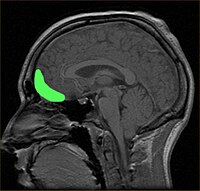
Photo from wikipedia
The ability to estimate numerosity in a visual array arose early in evolution, develops early in human development, and is correlated with mathematical ability. Previous work with visually presented arrays… Click to show full abstract
The ability to estimate numerosity in a visual array arose early in evolution, develops early in human development, and is correlated with mathematical ability. Previous work with visually presented arrays indicates that the intraparietal sulcus (IPS) represents number. However, it is not clear if the number signal originates in IPS or is propagated from earlier visual areas. Previous work from our group has demonstrated a rapidly instantiated representation of number in low-level regions of visual cortex using the high temporal resolution of event-related electro-encephalography (EEG). Here, we use a rapid event-related functional magnetic resonance imaging (fMRI) paradigm and find convergent evidence for a number signal in low-level visual cortex (areas V1, V2, and V3). Employing a stringent set of stimulus controls, we demonstrate that this signal cannot be explained by the total extent of the array, the density of the items in the array, the aggregate visual area of the items, the size of individual items, the proportion of the array covered by items, nor the overall scale of the array and items. Our findings thus provide strong support for the hypothesis that number is rapidly and directly encoded early in the visual processing stream.
Journal Title: Cortex
Year Published: 2019
Link to full text (if available)
Share on Social Media: Sign Up to like & get
recommendations!